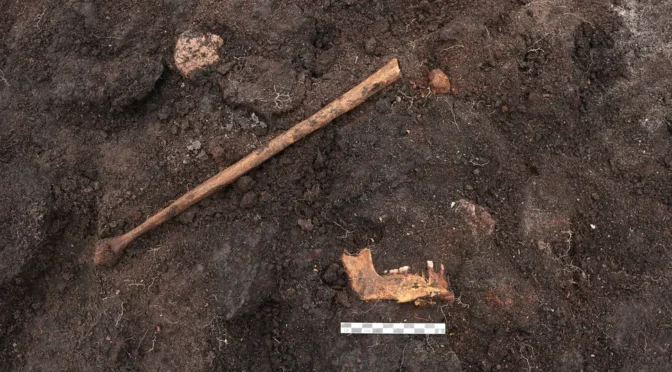5,000-year-old ‘bog body’ found in Denmark may be a human sacrifice victim
Archaeologists have discovered the ancient skeletal remains of a so-called bog body in Denmark near the remnants of a flint ax and animal bones, clues that suggest this person was ritually sacrificed more than 5,000 years ago.

Little is known so far about the supposed victim, including the person’s sex and age at the time of death. But the researchers think the body was deliberately placed in the bog during the Neolithic, or New Stone Age.
“That’s the early phase of the Danish Neolithic,” said excavation leader Emil Struve, an archaeologist and curator at the ROMU museums in Roskilde. “We know that traditions of human sacrifices date back that far — we have other examples of it.”
Dozens of so-called bog bodies have been found throughout northwestern Europe — particularly in Denmark, Germany, the Netherlands and Britain, where human sacrifices in bogs seem to have persisted for several thousand years.
“In our area here, we have several different bog bodies,” Struve told. “It’s an ongoing tradition that goes back all the way to the Neolithic.”

Ancient bones
The ROMU archaeological team found the latest set of bones in October ahead of the construction of a housing development. The site, which has now been drained, had been a bog near the town of Stenløse, on the large island of Zealand and just northwest of the Danish capital Copenhagen.
Danish law requires archaeologists to examine all land that’s to be built on, and the first bones of the Stenløse bog body were found during a test excavation at the site, Struve said.

The archaeologists will now fully excavate the site in the spring, when the ground has thawed after winter. But the initial excavations have revealed leg bones, a pelvis and part of a lower jaw with some teeth still attached. The other parts of the body lay outside a protective layer of peat in the bog and were not preserved, he noted.

Struve hopes that the sex of the body can be determined based on the pelvis and that wear on the teeth may indicate the individual’s age. In addition, the teeth could be sources of ancient DNA, which might reveal even more about the person’s identity, he said.

Bog bodies
Struve said the flint ax-head found near the body was not polished after it was made and may have never been used, and so it seems likely that this, too, was a deliberate offering.

The oldest bog body in the world, known as Koelbjerg Man, was found in Denmark in the 1940s and may date to 10,000 years ago, while others date to the Iron Age in the region from about 2,500 years ago.
One of the most famous and best preserved bog bodies is Tollund Man, who was found on Denmark’s Jutland Peninsula in 1950 and is thought to have been sacrificed in about 400 B.C.
A few of the bog bodies seem to have been accident victims who drowned after they fell in the water, but archaeologists think most were killed deliberately, perhaps as human sacrifices at times of famines or other disasters.
Miranda Aldhouse-Green, a professor emeritus of history, archaeology and religion at Cardiff University in the U.K. and the author of the book “Bog Bodies Uncovered: Solving Europe’s Ancient Mystery” (Thames & Hudson, 2015), said ancient people were likely well aware that bogs could preserve bodies.
